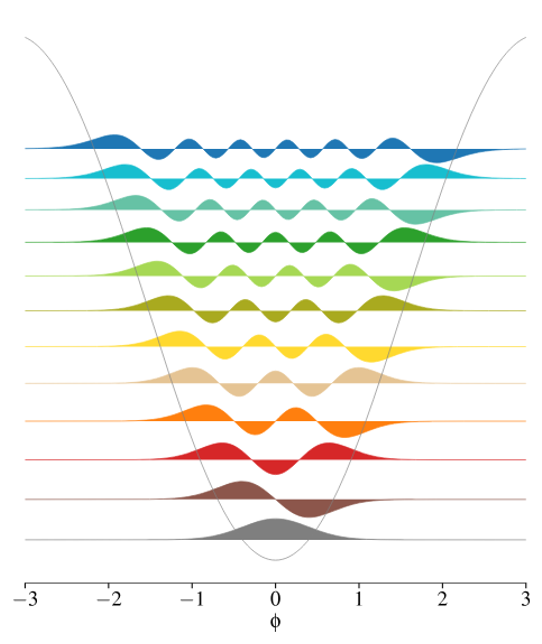 Beyond binary quantum information
Beyond binary quantum information
While most quantum processors encode binary information in two-level systems (qubits, d=2), the transmon circuit intrinsically features higher-level states owing to it’s cosine potential (figure left). Using these excited states, we are developing quantum processors that use many-level systems (qu-dits, d>2) as their elementary building block. Our lab recently measured up to 12 levels in a single transmon (d=12) [1] and demonstrated efficient methods for qudit control and readout [2] inspired by large-angular momentum spins.
A qudit processor poses a resource-efficient way to increase the available Hilbert space and strongly reduce the number of required entangling gates (that are typically the most difficult to perform) for a given algorithm. We develop planar qudit processors of coupled transmons, each locally encoding a high-dimensional qudit. A working five-qutrit processor was demonstrated in 2021 at UC Berkeley[3]. On the way to extending these concepts to higher qudit dimension, our lab explores many interesting research questions, including: Can we design a better circuit to encode qudits or is the transmon optimal? Can we employ quantum control techniques, inspired by NMR and quantum optics, to improve single-and mulitple-qudit gates? Can we run quantum computing, simulation -, and sensing protocols that demonstrate a clear qudit advantage over qubits? Is it possible to use a single high-dimensional qudit for quantum error correction?
Funded projects
“BE NON-LINEAR: Bosonic Encodings in NOise-resilient circuits with strong Non-LINEARity ”
AFOSR – Young Investigator Program
Relevant Publications
1 – High Ej/Ec transmon qudits with up to d=12 levels
Z. Wang, R.W. Parker, E. Champion*, and M.S. Blok
Phys. Rev. Appl. 23, 034046 (2025) |Arxiv:2407.17407
2 – Efficient Control of a Transmon Qudit Using Effective Spin-7/2 Rotations
E. Champion*, Z. Wang*, R.W. Parker and M.S. Blok
Phys. Rev. X 15, 021096 (2025) |Arxiv:2405.15857
3 – Quantum Information Scrambling in a Superconducting Qutrit Processor
M.S. Blok*, V. V. Ramasesh*, T. Schuster, K. O’Brien, J.M. Kreikebaum, D. Dahlen, A. Morvan, B. Yoshida, N. Y. Yao, I. Siddiqi.
Phys. Rev. X 11, 021010 (2021)| Arxiv:2003.03307


 Beyond binary quantum information
Beyond binary quantum information